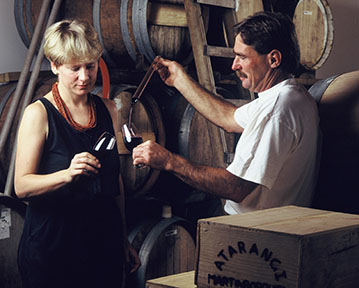Four of Martinborough’s Pinot Noir pioneers were celebrated, recognised and honoured at a large gathering of winemakers in July at Union Square Bar & Bistro.
The celebration was an opportunity to tell the country and world about the success of Martinborough and Wairarapa Pinot Noir. A large blind line-up of Wairarapa Pinot Noirs for media was followed by 55 invited guests enjoying sparkling Pinot Noir from Margrain Vineyard (one of Martinborough’s first wineries, starting life as Chifney Wines) and then a three-course degustation dinner prepared by Michelin-star chef Adam Newell.
The event recognised wine pioneers Derek Milne (a former soil scientist and co-founder of Martinborough Vineyard), Dr Neil McCallum (DSIR scientist and founder of Dry River Wines), winemaker Larry McKenna (of Martinborough Vineyard and then The Escarpment Vineyard) and Clive Paton, founder of Ata Rangi, whose life and business partner, Phyll Pattie, joined his journey shortly after he began.
“The Wairarapa wine region’s focus today remains as firmly on Pinot Noir as it has been for the past four decades,” said Wilco Lam, winemaker for On Giant’s Shoulders and committee member of Wairarapa Wine Region.
Soils were the conduit for early wine experimentation in this region. Scientist and wine lovers Derek Milne and Neil McCallum were part of a wine tasting group who met in Danny Schuster’s home in Lower Hutt to regularly taste and learn about classic wines of the world, which were “really affordable back then so we were able to obtain them and learn,” says McCallum.
This group led Schuster to North Canterbury while Milne and McCallum moved to Martinborough following a soil survey that Milne undertook. This paper was officially for horticultural purposes but its application to wine was clear.
The temperate climate, low rainfall, and free draining gravel soils are all necessary for quality grape growing and the production of fine wine and Milne’s findings led them to Martinborough. In the meantime, Clive Paton had heard about early wine experimentation in the region and, feeling more of a synergy with wine than with sharemilking, he also moved to Martinborough to make wine.
The rest is history.
“The dinner was not only to recognise the huge contribution of those early Pinot Pioneers to the development of the Martinborough wine region, but also to acknowledge that what they started has developed into a wine community that today produces wines of international quality from this region,” says John Porter of Porters Pinot Winery and Vineyards, the MC for the evening.
The three course dinner celebrated Pinot Noirs, old and new (including a 2008 Dry River Pinot Noir from magnum) with quail, duck confit and crème brulee and canalé served with aged Pinot Gris. The aim was to highlight the quality of the wines as well as the people who pioneered their early potential in this region.
White wines are also made to a high standard in the Wairarapa and have been recognised globally in awards and international accolades but Pinot Noir is the leading grape variety and flagship wine for this region with nearly 50 per cent of all vineyards in the area.
The Wairarapa Wine Region makes up 3% of New Zealand’s total vineyard area. It has 1090 hectares of vines in production, of which 527 hectares is Pinot Noir.



